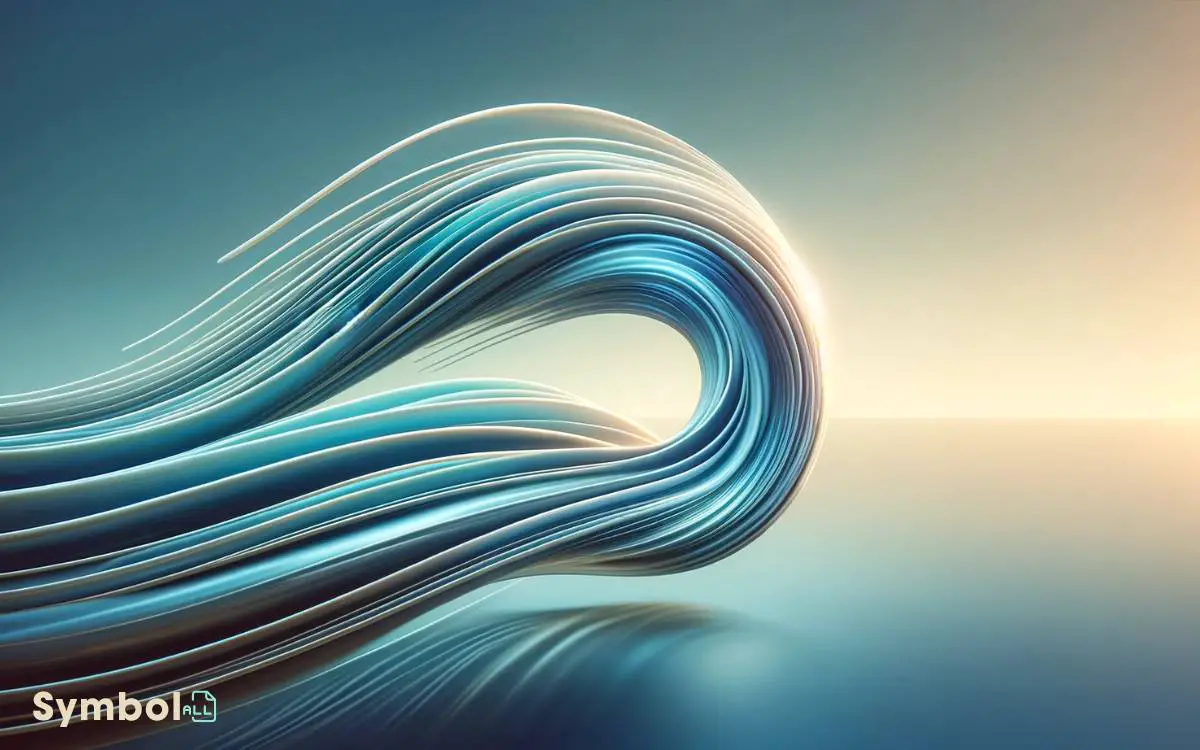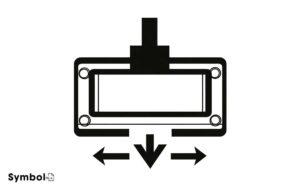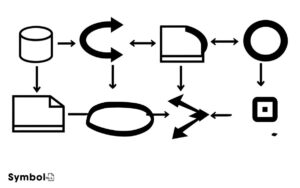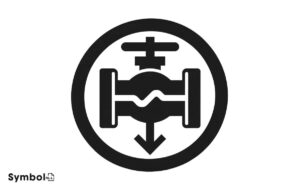Go With the Flow Symbol: Harmony And Adaptation!
The ‘Go With the Flow‘ symbol, deeply rooted in ancient cultures, signifies life’s perpetual motion and the natural cycles’ continuity.
Your exploration of its origins reveals a universal theme of harmony and adaptation, echoing through nature’s rhythms and the celestial dance.
Culturally, it’s a bridge across beliefs, harmonizing Eastern philosophies’ order with indigenous interconnectedness.
It’s not just a motif; it’s a guide through life’s complexities, embracing change. In modern contexts, it’s woven into mindfulness and self-care rituals, offering resilience.
This journey uncovers a shared human experience, symbolizing not just acceptance but a path to holistic well-being. You’ll uncover a deeper connection investigating further.

Key Takeaways
The Symbols Origins
The symbol’s origins can be traced back to ancient cultures, where it often represented the natural and perpetual motion of life’s cycles.
You’ll find that its conception isn’t rooted in a singular society but spans across numerous civilizations, each attributing its unique interpretation yet converging on the shared theme of continuity and flow.
Delving into the ethnographic layers, you’d uncover that these societies observed the rhythms of nature the seasons, water’s flow, or the celestial dance and sought to encapsulate these endless cycles through symbols.
This universal observation became a cornerstone in crafting symbols that transcended language barriers, conveying a fundamental understanding of life’s inherent flux.
Therefore, the symbol you’re curious about isn’t just an artifice but a profound expression of human connectivity to the world’s natural pace.
Symbolism and Meaning
As you explore the ‘Go With the Flow‘ symbol, you’ll uncover its origins and evolution, revealing how it’s been shaped by various cultural interpretations over time.
These interpretations offer a window into how societies have imbued this symbol with distinct meanings, reflecting their unique values and beliefs.
The psychological impacts of this symbol on individuals and communities further highlight its significance, demonstrating how it resonates on a deeply personal level across diverse contexts.
Origins and Evolution
Understanding the symbol’s origins and evolution reveals how its meaning has flowed through various cultures, adapting to each’s unique context and belief systems.
Initially, the symbol may have emerged from natural phenomena, representing the literal flow of water a source of life, sustenance, and change.
As societies developed, the symbol’s significance deepened, intertwining with philosophical, spiritual, and artistic expressions. It began to embody concepts of time, movement, and metamorphosis, resonating with human experiences of growth and change.
Ethnographic investigations suggest that its adaptability is its strength, allowing the symbol to maintain relevance across epochs.
This fluidity mirrors the very essence of the symbol ever changing, yet fundamentally connected to the core of human existence, marking it as a timeless emblem of life’s perpetual motion.
Cultural Interpretations
Exploring how different cultures interpret the flow symbol reveals a rich tapestry of meanings, each woven with its own historical, philosophical, and spiritual threads.
In Eastern traditions, it often symbolizes the seamless cycle of life, death, and rebirth, emphasizing the importance of moving with life’s inevitable changes.
Native American cultures, meanwhile, might see it as representing the river of life, highlighting the interconnectedness of all beings.
In modern Western contexts, it’s frequently associated with adaptability and resilience in the face of life’s unpredictability.
Each interpretation, deeply rooted in its cultural context, offers a unique lens through which to view the concept of flow, enriching our understanding of this universal symbol.
Through these varied perspectives, you’re invited to appreciate the depth and diversity of human thought surrounding the flow symbol.
Psychological Impacts
Why do symbols, like the flow symbol, profoundly affect our psychological state, shaping our perceptions and emotions in significant ways?
This impact stems from an inherent human tendency to find meaning and order in visual cues.
The flow symbol, often representing harmony and continuity, taps into our deep-seated desires for stability and progression. It’s not just a visual element; it’s a confirmation reflecting our collective anxieties and aspirations.
Within this context, you’re likely to experience a sense of calm or motivation when encountering this symbol. It acts as a subtle guide, encouraging you to embrace change and move with life’s rhythm.
This psychological interaction isn’t just incidental; it’s a validation of the power of symbolism to influence our mindset and behavior, anchoring us in a world that constantly ebbs and flows.
Cultural Significance
Across cultures, the Go With the Flow symbol holds varied meanings that deeply resonate with local traditions and beliefs. In Eastern philosophies, it’s emblematic of harmony and the natural order of the universe, urging individuals to embrace change and uncertainty with grace.
Indigenous tribes might see it as a representation of the interconnectedness of life, emphasizing the importance of living in balance with nature.
Analyzing these interpretations, you’ll notice a common thread: the symbol serves as a guide for maneuvering life’s complexities. It’s not just an icon; it’s a philosophical compass that encourages a deep, introspective journey.
This cross-cultural reverence highlights the symbol’s capacity to transcend geographical boundaries and connect people through shared human experiences.
Modern Adaptations
While the Go With the Flow symbol has deep roots in various cultures, its metamorphosis into modern contexts reveals its adaptability and ongoing relevance.
You’ll find this symbol woven into the fabric of contemporary mindfulness movements, embodying principles of acceptance and resilience amidst life’s unpredictability.
It’s fascinating to observe how this ancient emblem has seamlessly shifted into digital spaces, becoming a popular motif in online communities that advocate for mental well-being and stress reduction.
This digital change underscores a collective yearning for balance and the symbol’s potent reminder to embrace life’s ebbs and flows.
Further, its incorporation into educational tools and psychological practices demonstrates a nuanced understanding of its significance, bridging traditional wisdom with modern therapeutic approaches.
In Art and Design
In art and design, the flow symbol isn’t just a motif but a profound emblem of movement and change. It’s intricately woven into the fabric of the creative process, guiding artists and designers in their quest for dynamic expression.
This symbol’s impact on both the creator’s approach and the audience’s interpretation highlights its pivotal role in shaping artistic narratives and experiences.
Symbolic Representation Impact
Many symbols in art and design carry profound meanings that greatly influence viewers’ perceptions and interpretations. These symbols serve as bridges between the creator’s intent and the audience’s comprehension, embedding layers of understanding within a visual context.
Your engagement with these symbols can be transformative, guiding you through a nuanced exploration of themes, histories, and ideologies.
Here’s a breakdown of their impact:
- Cultural Reflection: Symbols encapsulate cultural identities, preserving heritage and narrating collective histories.
- Emotional Resonance: They evoke emotions, connecting deeply with individuals’ experiences and feelings.
- Ideological Expression: Symbols articulate political, social, and philosophical ideologies, often inciting reflection or action.
- Universal Language: They transcend linguistic barriers, enabling a global dialogue that fosters mutual understanding and empathy.
In dissecting these symbolic representations, you’re not just observing; you’re actively participating in a rich, ethnographic tapestry that spans across time and cultures.
Creative Process Integration
Integrating symbols into the creative process enriches art and design with deeper meanings, fostering a dynamic interaction between creators and audiences. You’re not just crafting visuals or objects; you’re weaving a complex narrative that resonates on multiple levels.
This approach demands a meticulous understanding of cultural, historical, and personal contexts. It’s about seeing beyond the surface, recognizing that every symbol carries weight, stories, and potential for interpretation.
You’re tasked with decoding these symbols, aligning them with your artistic vision, and embedding them seamlessly into your work.
This integration isn’t superficial; it’s a thoughtful amalgamation that enhances the communicative power of art.
Through this lens, your creations become more than aesthetic objects; they emerge as dialogues, inviting viewers into a shared space of exploration and discovery.
Personal Empowerment
Embracing personal empowerment, you harness the potential to navigate life’s challenges with resilience and autonomy. This journey involves a deep understanding of self and the recognition of your inherent power to influence your life’s direction.
Through an ethnographic lens, we observe how personal empowerment unfolds in various cultural contexts, revealing universal principles:
- Self-awareness: Identifying your strengths, weaknesses, and values.
- Decision-making: Taking charge of your choices with confidence.
- Boundary-setting: Establishing limits to protect your energy and focus.
- Growth mindset: Embracing challenges as opportunities for development.
These elements serve as the foundation for a life led with purpose and intent. In embracing them, you’re not just surviving; you’re thriving, crafting a narrative of empowerment that’s uniquely yours.
Practical Applications
To effectively apply the principles of personal empowerment in daily life, you must start by critically evaluating your current habits and routines. This process is not merely about identifying what you do, but understanding the contextual and ethnographic layers behind these actions.
It’s about dissecting the fabric of your daily life to discern patterns that either empower or hinder you.
| Habit | Empowerment Impact |
|---|---|
| Morning routine | Sets a positive tone for the day |
| Social media consumption | Can drain or uplift, depending on use |
| Reflective practices | Enhances self-awareness and growth |
In this analysis, you’re not just looking at what you do, but also why and how these activities contribute to or detract from your sense of empowerment.
It’s a nuanced examination, requiring you to be both participant and observer in your own life, always with the goal of enhancing personal empowerment.
Conclusion
As you navigate the river of life, the ‘go with the flow‘ symbol serves as your compass, reminding you to embrace change as the water embraces its course.
This ancient emblem, rooted in diverse cultures, teaches adaptability, resilience, and the art of finding harmony in life’s tumultuous currents.
In its modern adaptations, it’s a beacon for personal empowerment, guiding you through the ebbs and flows of existence. Like water, you too are called to move, adapt, and evolve, finding strength in fluidity.






